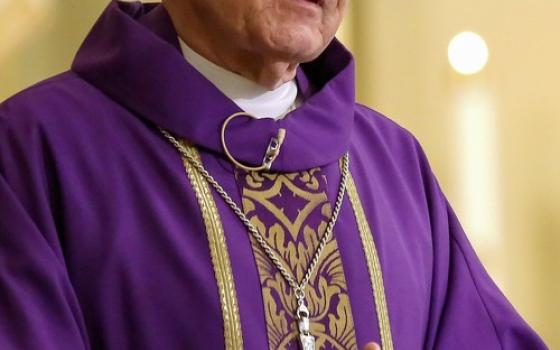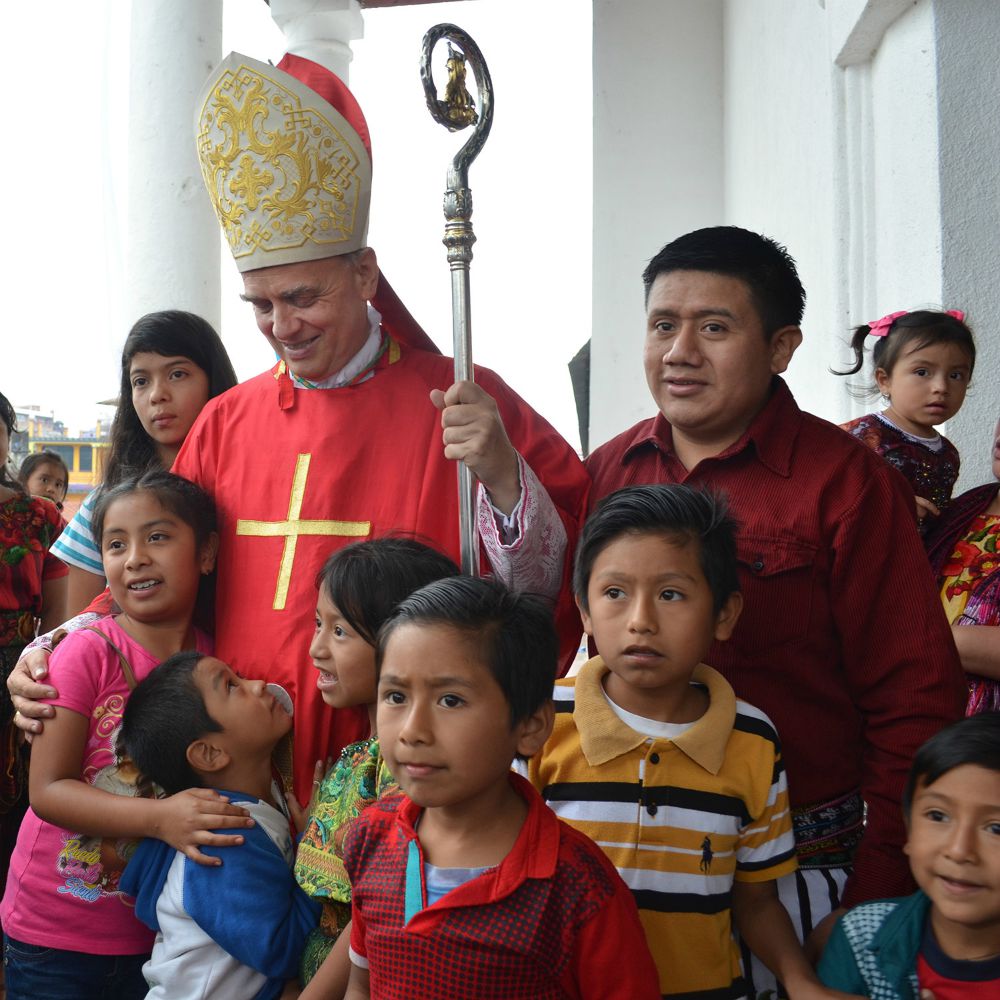
Archbishop Nicolas Henry Thevenin, the apostolic nuncio of Guatemala, stands with children after the beatification Mass for martyr Fr. Stanley Rother at Santiago Apostal (St. James the Apostle) Church in Santiago Atitlán, Guatemala Sept. 23. (Fotokids/Chonita Rabinal)
Sept. 23, townspeople celebrated the beatification of their beloved "Padre Apla's" * with an outpouring of prayer, song and splendid display that commemorated his violent death and road to sainthood as the first U.S.-born martyr — although the faithful here claim Stanley Francis Rother as their own.
"He is our example of love," said Juan Ratzan Mendoza, who was married to his wife Antonia Ajcot by Rother, along with 60 other couples, two days before the Oklahoma priest's murder by a government death squad.
"He spoke our language well," said 78-year old Maria Pablo Mendoza. At dawn on July 28, 1981, men went through the streets crying, "They killed our priest!" His parishioners had expected it. Maria Pablo said she heard the church bells ringing and "wept and wept."
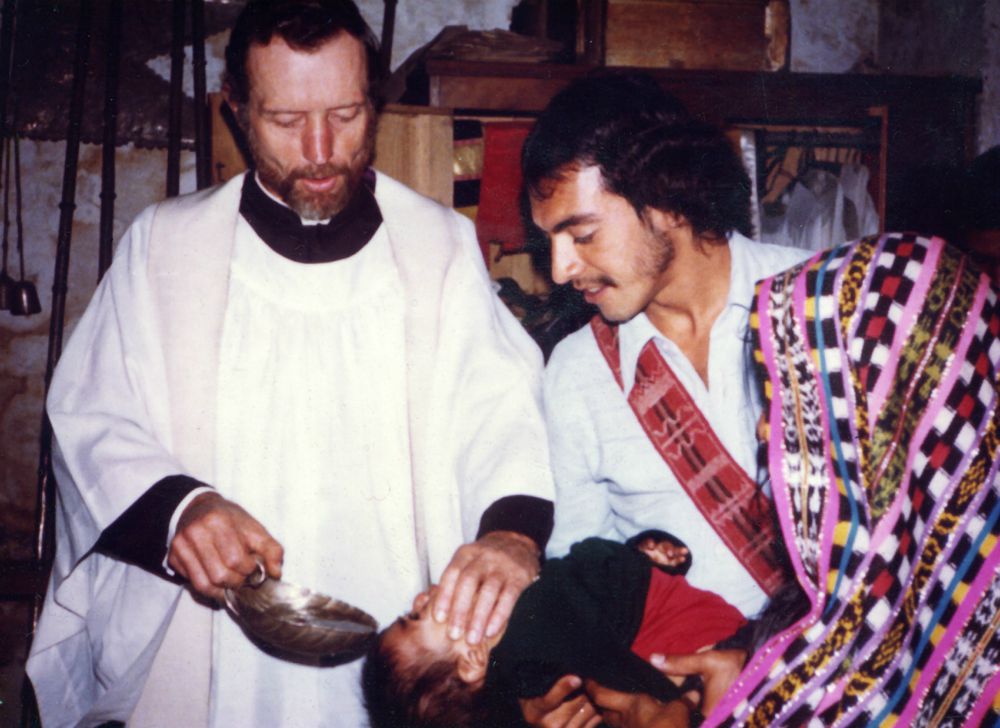
Fr. Stanley Rother, a priest of the Oklahoma City Archdiocese who was murdered in 1981 in the Guatemalan village where he ministered, is shown baptizing a child in this undated photo. (CNS)
This town on the rim of the sapphire blue Lake Atitlan, surrounded by three volcanoes, was one of the hardest hit in violence that cost 200,000 lives during Guatemala's 36-year war that ended in 1996. Most of the dead were unarmed indigenous Maya, like the Tzutujil Maya who live here, cut down by a brutal army. "I don't want to desert these people," Rother wrote to the bishops of Tulsa and Oklahoma City in 1980. He hid threatened men and boys, and decried attacks before officials. The government regarded the indigenous as allies of leftist guerrillas because they wanted the same kind of changes the guerrillas said they wanted.
"The low wages that are paid, the very few who are excessively rich, the bad distribution of land — these are some of the reasons for the widespread discontent," Rother wrote to his bishops. "The Church seems to be the only force that is trying to do something [about] the situation, and therefore the government is after us." Thirteen priests and hundreds of catechists were killed nationwide during the violence.
On the eve of the beatification, upon a rise where a Maya temple once stood, parishioners filled one of the oldest churches in the Americas (capacity: 1,500), St. James the Apostle. For five hours they celebrated Mass, watched a documentary about Rother's life and a startling, dramatic recreation by parish youth of his murder. Having arrived by boat, the papal nuncio Archbishop Nicolas Henry Thevenin took almost an hour to walk the few blocks from dock to church, regaled by the townspeople, who are called Atitecos. The church went dark as women in traditional woven dress and indigo head shawls processed with candles, and an arc of candles flickered above the altar during veneration of the Blessed Sacrament.
The fervor of the hours felt memorable even to those who know the congregation well. "Inexplicable, extraordinary," said Sr. Concepción Xeché of the Missionary Sisters of the Eucharist, a nurse in the hospital Rother founded. "This blessing will bear fruit in priestly vocations, real marriages and example for the young."
The next day men put on their best clothing woven through with images of birds and animals, and women gathered in the churchyard to wind yards of woven ribbon around their heads in a traditional headdress worn on the most important occasions. As Rother was being beatified in Oklahoma, Atitecos packed the local church until there was hardly room to move.
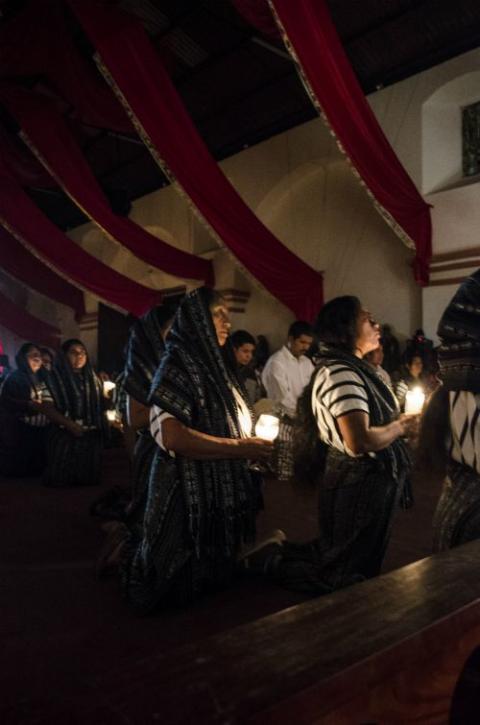
Women participate in a candlelight vigil during Mass Sept. 22 on the eve of the beatification of martyr Fr. Stanley Rother. (Fotokids/Chonita Rabinal)
"Padre Apla's was part of my vocation, of attention to the most needy," said Fr. Manuel Yojcom, using the familiar name — Tzutujil for Francis — by which Rother was known. Yojcom, a Tzutujil priest from another lake village, San Pedro La Laguna, concelebrated the Mass in honor of the beatification with Thevenin, Bishop Gonzalo de Villa y Vásquez, and more than a dozen priests including Americans Fr. John Spain, a Maryknoll working in El Salvador, and Rother's successor in Santiago until 1996, Fr. John Vesey.**
"This is a blessing for the poor, to see him recognized," said Vesey as he watched parishioners still streaming into the church. "I hope this will inspire Guatemala to recognize all their holy martyrs."
When Rother was killed, the Catholics of Santiago begged to keep his heart and the blood that spilled at his death, and Rother's family agreed. The relics have been enclosed in an altar, kept from view, under a picture of Rother. After the Mass, Sept. 23, Archbishop Thevenin led a procession through the streets while holding high a monstrance containing a glass vial of Rother's blood.
Depression-era agrarian heritage
Considering Stanley Rother's humble beginnings, it is safe to say he would have been amazed to see the events in his honor. "He did not act superior, he was one of us," said Gaspar Mendoza, the president of the parish council.
On the day Rother was born in 1935 in Okarche, Oklahoma one of the worst storms of the Dust Bowl era was blowing through the family farmstead. While his mother, Gertrude, was in labor with her first-born, his father Franz was in the barn, where a mare was foaling.
Advertisement
Perhaps the very reality of farm life that Stan Rother came to know, and the uncertainties inherent in farming — will the crop fail with the bad weather? — helped to make him feel at home in Santiago, where men and boys dig the soil to plant corn and beans, and women stand knee-deep in the lake to slap the family wash against rocks. Rother spoke the same language of working the earth to produce food as local peasants did. He was physically strong, and "he could fix things," Atitecos say, not only a priest but a mechanic, carpenter and farmer pitching in where needed.
Stanley Rother almost didn't make it to Santiago, indeed he almost never became a priest. After six years, having wrestled with Latin — the language of textbooks — and failing theology twice, he was asked to leave the seminary.
When he went home, the Rother family pastor from Holy Trinity Church in Okarche accompanied father and son to meet with Oklahoma City Bishop Victor Reed, who recognized something in the disappointed young man, not the least his desire for the priesthood. He sent Rother to a different seminary, where he made fine progress and was ordained in 1963. In 1968, Rother answered a diocesan call responding to the request of Pope John XXIII for priests, sisters and non-consecrated lay people to fill needs in Latin America.
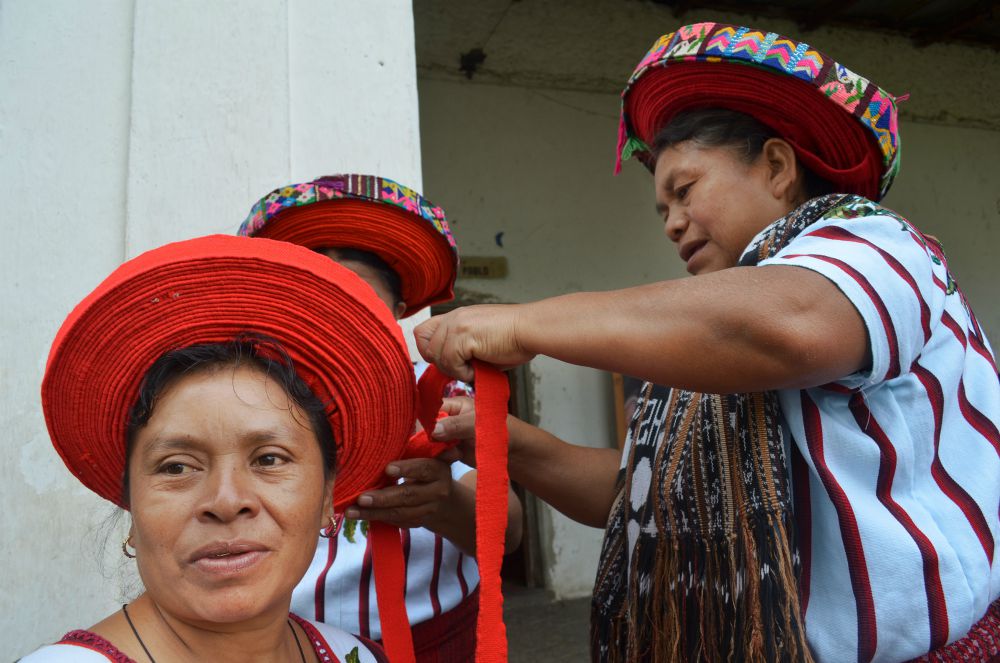
Women dress each other in traditional "tocoyal" headwear in preparation for Mass. (Fotokids/Chonita Rabinal)
In Santiago, Rother came to speak not only Spanish but the far more difficult Maya language of his parishioners, Tzutujil. The ancient tongue was unwritten until 1966 when Fr. Ramon Carlin, Rother's predecessor from the Oklahoma mission, began working with two parish men to commit its sounds to paper, a project pursued energetically by Rother. Most Atitecos then did not even speak Spanish, and many women still do not. On one anniversary of Rother's assassination, upon the coffin that represented his remains, parishioners placed a folder that held the Tzutujil translation of the Holy Mass.
Rother took grave risks to make sure the translation of the New Testament continued despite the violence, secretly moving a threatened translator, Juan Mendoza Lacán, to a safe house in Guatemala City, visiting him to bring food, and when possible, Mendoza's wife and five children. "Padre Apla's was enculturating the Gospel for us," making it understood in the world of the Tzutujil faithful, said Mendoza's son Juan Ramon, 43.
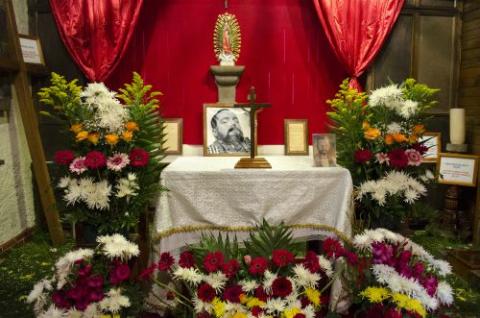
The room where Fr. Stanley Rother was murdered is now a chapel of adoration. (Fotokids/Chonita Rabinal)
But collaborating with the American priest was dangerous. Juan Ramon remembers how Rother stood with the family under the burned beams of their house after attackers set it afire, and tried to convince his father to go into exile. "He said, 'I won't lose anything by staying, I have no family, but you do.' " But Juan Ramon's father wanted to finish the work, and be near his family. A year after Rother's assassination, a death squad pulled Juan Mendoza Lacán from a bus, and he was not seen again. Today his son heads a parish committee to pray for Rother's cause and tell his story. "He planted a good seed in us," he said.
Just as he wanted Scripture deeply understood by the Tzutujil, Rother was also open to traditionalists who practiced an older Maya form of Christianity. Brotherhoods called cofradias helped the earliest Spanish friars carry out liturgies, then cared for the church and its images for centuries when Santiago had no resident priest and provided social services and prayed in a manner that included ancient ways. Rother walked in procession with present-day cofrades, even though some consider them throwbacks or pagan, and he befriended them as individuals. He believed the Tzutujil past was an important part of the Atitecos' present, of who they were as a people, and deserved evangelization with this in mind.
Miguel Pablo Sicay, 42, a cofradia sacristan, compares Rother to a Maya prophet, Francisco Sojuel, who appeared "in a time of hunger" and "made the land produce," improving lives. Rother had a "very special way" with the sacraments, said Sicay. "He talked about equality of people and equilibrium, that people should love each other, like the harmony of our Maya cosmovision — he said this was the word of God."
I have shown you many good works from the Father; for which of these do you wish to kill me? Sololá Bishop Angélico Melotto quoted Jesus' words in a Mass for Rother shortly after his death.
Hands-on pastor
Some peasant farmers had to walk three hours to their subsistence fields; Rother started a 110-acre cooperative where they could experiment with fertilizers and higher-yield corn and try new plants — garlic, rice, wheat as cash crops, Haas avocados from seeds he brought from the States. He brought in the first tractor most had seen. He began a weaving cooperative that helped women to earn cash, starting with priests' stoles. Santiago's undernourished children often died young — a measles epidemic killed 600 in 1964 — and for people of all ages, treatable conditions like diarrhea, flu, or an infected machete cut could be a death sentence; Rother started a hospital that still serves the community, helping to build its walls with his own hands.
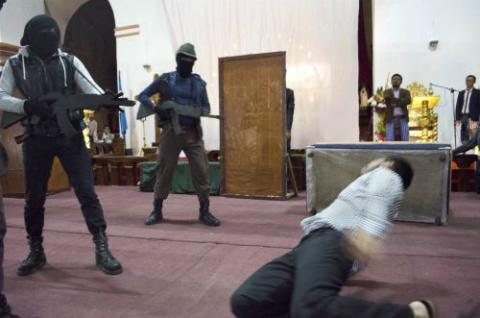
Young people from the church youth group re-enact the murder of Fr. Stanley Rother by the military in what was then a sitting room in the church, and was later made into a chapel. (Fotokids/Chonita Rabinal)
"His social works were important not because they were social but because as a pastor he realized it was difficult for people to be spiritually strong while they were physically damaged, hungry," said the papal nuncio in an interview with NCR. Rother tended his parishioners, said Archbishop Thevenin, "without politics — only with his heart."
Rother's martyrdom came most directly from his commitment to accompany the people of Santiago in their darkest hour, instead of fleeing as other clergy in the country and even a bishop felt forced to do.
"A shepherd does not leave his flock," he said.
On Jan. 7, 1981, an army truck hit a guerrilla mine, and soldiers killed 18 defenseless civilians in retribution. The bloodied bodies were laid out in the church square, but only the bravest wives and mothers had the courage to defy the terror of the army and claim loved ones. Rother stood by each woman as she did, one by one, and when seven bodies remained unclaimed, he took them inside, had coffins made and gave them a Christian burial. In early 1981, Rother's name appeared on a death list. He continued to check morgues and hospitals in distant towns when his catechists or other parishioners went missing, or searched the roadside where a body might have been thrown. He kept careful account of widows and children left behind, even though "helping these people could very easily be considered subversive by the local government," he wrote. In July, 1981, word spread that the army was going to forcibly recruit local youth during the town's saint's day fiesta, so he opened the church to 500 young men who slept on the floor.
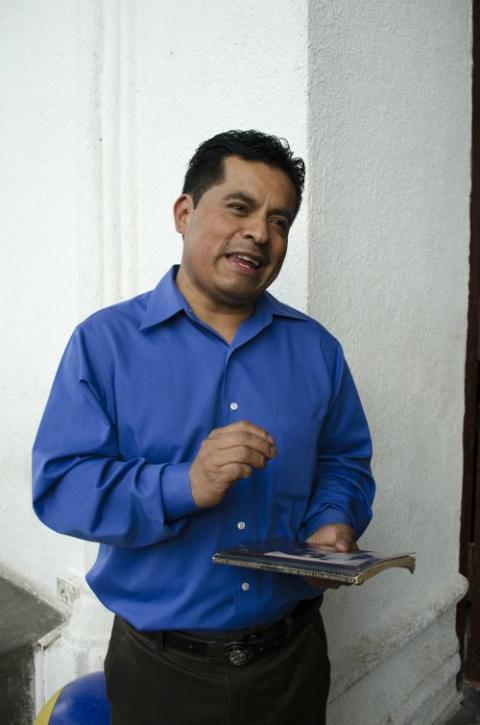
Juan Ramón Mendoza, son of the person who worked with Fr. Stanley Rother to translate the new testament in Tzutujil and who was subsequently murdered by the military as a result of his work (Fotokids/Chonita Rabinal)
"Even when we were sleeping inside we could hear gunshots," said Diego Chavez, who stayed inside the church three nights then slept in a series of houses to avoid capture. In happier times, Chavez helped his father carve a magnificent wooden altar at Rother's request that reflects all aspects — including the traditional — of the spiritual life of the community.
Rother never denied his precarious situation with the army, but he often said he would not be taken alive. He would not risk divulging information under torture that could harm others, did not want parishioners to go through the experience of searching for his body. On July 28, 1981, three armed men in ski masks forced the rectory guardian to lead them to Rother's room. He called out, "Father, they are looking for you," and the priest opened the door to protect the young man. Rother shouted, "Kill me here!" and fought so hard that the skin on his fists was torn bare and his blood leaped onto a wall. Finally one of the attackers got off two shots, one to Rother's face, the other to his left temple.
Sisters sleeping in another part of the building heard the noise and rushed to the scene, but all they could do was pray and reverently gather their pastor's spilled blood into the handiest receptacle, a canning jar. In recent preparation for the beatification, two people who saw the blood said it looked as if it had been shed yesterday, red, liquid.
Gaspar Mendoza, 51, who received his first holy Communion from Rother, considered the priest's last moments. "Maybe his body felt fear, but his spirit, no," he said.
[Mary Jo McConahay is a longtime contributor to National Catholic Reporter. Her book on World War II in Latin America, Tango War: The Struggle between the Axis and the Allies for the Hearts, Minds and Resources of Latin America, 1933-1945, appears in 2018 by St. Martin's Press.]
*The spelling of Fr. Stanley Rother's familiar name has been corrected.
**The name of the priest has been corrected.






